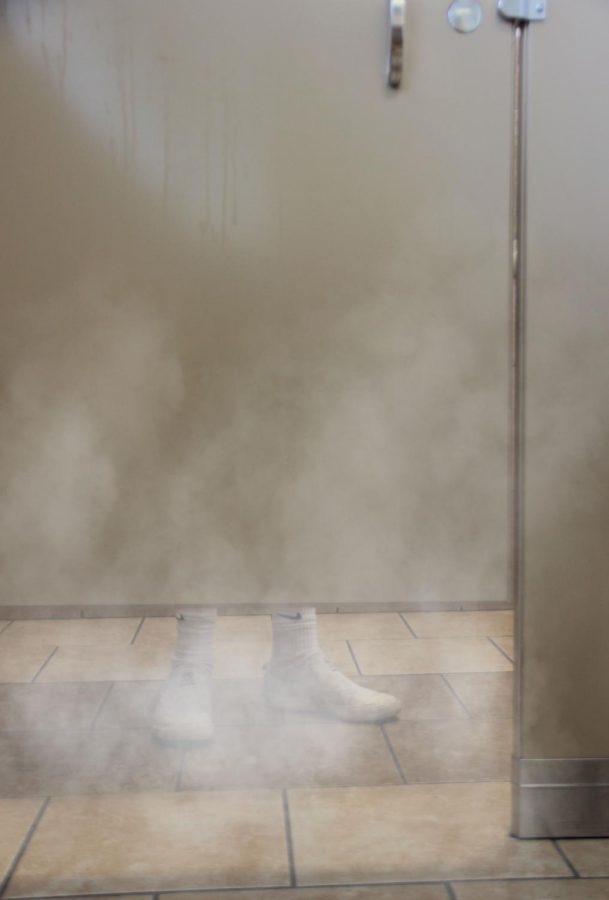Vaping Returns
The Highland administration is concerned about the number of students vaping in the bathrooms.
November 5, 2021
When John Price, head of security for Highland, read an article celebrating the drop in the number of teens vaping, he didn’t believe it. The numbers cited in the article went against what he sees at Highland every day, and he wasn’t happy.
Despite the statistics in the article saying that teen vaping numbers were down, Price says that from what he’s seeing, they are anything but.
“It’s consistent [with previous years],” Price said about the number of students who are vaping. “I’d say about 10 percent of the population.”
Price says that he feels that the story did not reflect what is happening in schools– and that’s a problem.
“I don’t want to be a part of saying that vaping is down,” Price said.
Vaping hit its peak in the 2018-19 school year, when schools saw a huge increase in the number of students vaping. Bathrooms around the building became a popular spot for students to vape, because of the privacy that could be found there during class time.
Highland is seeing the same trend now, with students returning to the building.
When it comes to why the school is still seeing a significant portion of the student body vaping, Jeremy Chatterton, Highland’s principal, cites vaping being easier to get away with than smoking as one reason.
“You don’t have the smell aspect [that you would with cigarettes],” Chatterton said.
A Highland student who vapes says that vaping in school has its pros and cons.
“There’s a lot of kids vaping so if you needed a product, you could probably hit them up and ask for stuff,” they said. On the other hand, “If you’re being stupid and doing it in the bathroom and a teacher walks in, you’re screwed, and it’s easy to smell.”
Despite the risk of getting caught, this student says they continue to vape for the same reason many people do– it’s addictive.
After being abused by an ex-boyfriend, they started smoking. They later switched to vaping to stop smoking, which worked. But now they are having a hard time quitting vaping.
This student says that they’ve tried several strategies for quitting, including going to a therapist.
“Their advice was unrealistic and unhelpful,” the student said.
Now, they’re trying to lower their use and tolerance bit by bit and lean towards friends for support.
This student says that they also hope campaigns against vaping will switch tactics and stop trying to just scare teens away from vaping, but rather educate them on the dangers vaping poses.
However, for students who have already been caught vaping, there are consequences, depending on what they were vaping.
“A mandatory call home, parent/guardian talk, and it may even lead to a day suspension,” Price said about the potential consequences.
In addition to the steady numbers of students vaping, Price says that another trend is emerging. He’s been seeing students moving away from products that contain nicotine and begin using products with THC.
The use of THC is especially concerning after the Food and Drug Administration released a warning in 2019 telling people to not use any vaping products with THC after over 1,000 reports of lung injuries were investigated for their ties to vaping products containing THC.
However, the Highland administration is still concerned about students vaping anything, whether it contains THC or not.
“It’s obviously a concern for us. We want to make sure everyone’s safe and understands the consequences of putting who knows what into their body and their lungs,” Chatterton said.
Judi Yaworsky, nurse for the Salt Lake City School District, says that there are many hazards that come with vaping.
Yaworsky says these hazards stem from the ingredients used in the e-liquid that is vaporized and inhaled. Among other ingredients, e-liquids contain flavorants, chemicals that help it go from a liquid to a vapor, and nicotine.
The harmful effects of nicotine have been well documented. Not only is it highly addictive, but it also changes the way synapses (pathways in the brain that are made when new memories are made or skills are learned), are formed. This is especially harmful to teens with developing brains that form new synapses more rapidly. According to Yaworsky, adolescent brains learn much faster than adult brains. This makes addiction, a learned behavior, a much bigger risk for teens.
Along with nicotine, the flavorants and vaporizing chemicals used in e-liquids pose a threat to users’ health. Chemicals found in these ingredients can also be found in car exhaust, which is notoriously bad for the lungs.
When it comes to flavorants specifically, companies that make vaping products may say that they are perfectly safe. That’s true- to an extent. Flavorants have been known to be safe to eat, but not to inhale.
Yaworsky’s advice boils down to one major point:
“People shouldn’t put anything in their lungs but air,” Yaworsky said. “You will damage them.”






























